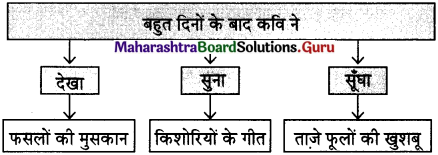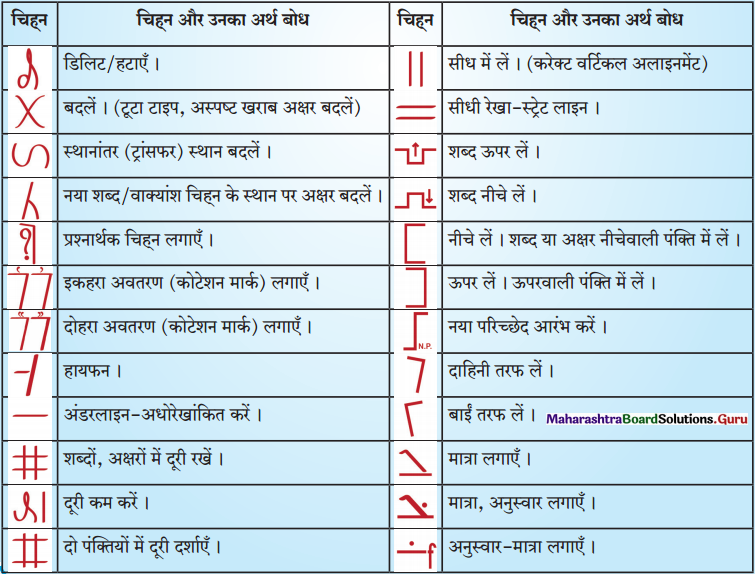Balbharti Maharashtra State Board Hindi Yuvakbharati 11th Digest अपठित गद्यांश Notes, Questions and Answers.
Maharashtra State Board 11th Hindi अपठित गद्यांश
प्रश्न 1.
गद्यांश पढ़कर दी गई सूचनाओं के अनुसार कृतियाँ कीजिए:
उत्तरः
साहब सन्नाटे में आ गए। फतहचंद की तरफ डर और क्रोध की दृष्टि से देखकर काँप उठे! फतहचंद के चेहरे पर पक्का इरादा झलक रहा था। साहब समझ गए, यह मनुष्य इस समयं मरने-मारने के लिए तैयार होकर आया है। ताकत में फतहचंद उनके पासंग भी नहीं था।
लेकिन यह निश्चय था कि वह ईंट का जवाब पत्थर से नहीं, बल्कि लोहे से देने को तैयार है। यदि वह फतहचंद को बुरा-भला कहते हैं, तो क्या आश्चर्य है कि वह डंडा लेकर पिल पड़े। हाथापाई करने में यद्यपि उन्हें जीतने में जरा भी संदेह नहीं था; लेकिन बैठे-बिठाये डंडे खाना भी तो कोई बुद्धिमानी नहीं है।
कुत्ते को आप डंडे से मारिए, ठुकराइए, जो चाहे कीजिए, मगर उसी समय तक, जब तक वह गुर्राता नहीं। एक बार गुर्राकर दौड़ पड़े, तो फिर देखें, आपकी हिम्मत कहाँ जाती है? यही हाल उस वक्त साहब बहादुर का था। जब तक यकीन था कि फतहचंद घुड़की, घुरकी, हंटर, ठोकर सब कुछ खामोशी से सह लेगा, तब तक आप शेर थे; अब वह त्योरियाँ बदले, डंडा सँभाले, बिल्ली की तरह घात लगाए खड़ा है।
ज़बान से कोई कड़ा शब्द निकला और उसने डंडा चलाया। वह अधिक-से-अधिक उसे बर्खास्त कर सकते हैं। अगर मारते हैं, तो मार खाने का भी डर।
उसपर फौजदारी में मुकदमा दायर हो जाने का अंदेशा-माना कि वह अपने प्रभाव और ताकत से अंत में फतहचंद को जेल में डलवा देंगे; परंतु परेशानी और बदनामी से किसी तरह न बच सकते थे। एक बुद्धिमान और दूरंदेश आदमी की तरह उन्होंने यह कहा –
‘ओहो, हम समझ गया, आप हमसे नाराज हैं। हमने क्या आपको कुछ कहा है? आप क्यों हमसे नाराज हैं।’ फतहचंद ने तनकर कहा – ‘तुमने अभी आधा घंटा पहले मेरे कान पकड़े थे और मुझे सैकड़ों ऊलजलूल बातें कही थीं। क्या इतनी जल्दी भूल गए?’

प्रश्न 2.
संजाल पूर्ण कीजिए :

उत्तरः

प्रश्न 3.
चौखट में उत्तर लिखिए?

उत्तरः



प्रश्न 4.
(i) गद्यांश से शब्दयुग्म ढूँढ़कर लिखिए –
(1) ……………………………………
(2) ……………………………………
उत्तरः
(i) बुरा – भला
(ii) बैठे – बिठाए
(ii) लिंग परिवर्तन कीजिए –
(i) शेर – ……………………………………
(ii) नौकर – ……………………………………
उत्तरः
(i) शेर – शेरनी
(ii) नौकर – नौकरानी
प्रश्न 5.
‘ईंट का जवाब पत्थर से’ इस मुहावरे को चरितार्थ करता हुआ कोई प्रसंग 10-12 पंक्तियों में लिखिए।
उत्तरः
‘ईंट का जवाब पत्थर से देना’ एक प्रचलित हिंदी मुहावरा है। जिसका अर्थ है कड़ा प्रतिरोध करना या मुँहतोड़ जवाब देना। दुष्ट लोगों के साथ दुष्टता से पेश आना। भारतीय सेना के जाबाज सिपाही सीमा पर अपने दुश्मनों को मुँहतोड़ जवाब देकर उन्हें सबक सिखाते हैं। हमारी रोजमर्रा की जिंदगी में भी ऐसे प्रसंग देखने को मिलते हैं। एक बार सिग्नल पर एक बाइक पर सवार युवक साइकिल पर सँवार लड़की के साथ ऊलजलूल बातें कर रहा था।
लड़की उसकी गुस्ताखी के शालीनता से जवाब दे रही थी। इतने में सिग्नल हुआ और बाइक सँवार चल पड़ा। अब लड़की ने उसका पीछा किया और ऐसा सबक सिखाया कि वह जिंदगी में कभी किसी लड़की को नहीं छेड़ेगा। हाँ, लड़की के विरोध करने पर उसकी मदद के लिए अन्य लोग भी आए और अंत में पुलिस भी आई। लेकिन पहल लड़की ने की और बड़ी हिम्मत दिखाई। उस बाईक सँवार को उसने सड़क के किनारे रोककर दो तमाचे जड़ दिए।
भीड़ जमा हो गई और सब लड़की की ओर से होने के कारण लड़के को शर्मिंदा होना पड़ा। पुलिस ने उसपर एफआयआर कर दी और उसका लाईसेन्स ले लिया। जुर्माना भरना पड़ा, शर्मिंदगी उठानी पड़ी, ये हुई न ‘ईंट का जवाब पत्थर से’ वाली बात।
प्रश्न 6.
गद्यांश पढ़कर दी गई सूचनाओं के अनुसार कृतियाँ कीजिए :
उत्तरः
एक बार शरीर के अंगों में लड़ाई हो गई। इसका आरंभ पैरों ने किया। वे बोले: लड्डू लाना हो या पेड़ा, कचौरी लानी हो या आलू की टिकिया, हमें ही दौड़ना पड़ता है, पर चीज़ लेते ही हाथ उसे थाम लेते हैं, मुँह चट कर जाता है, आँखें देखती हैं, पेट खा जाता है, नाक सूंघती है, हमें क्या मिलता है- हम क्यों बेगार करें! आज से हम नहीं चलेंगे, तो खाते हैं, लेते हैं, वे ही जाएँ, वे ही दौडें।
बस, पैरों की देखा-देखी औरों को भी सूझी। हाथों ने कहा: तुम चलकर जाते हो तो क्या, ढोकर तो हमीं लाते हैं, पर हमें क्या मिलता है, यह अकेला मुँह सब कुछ चट कर जाता है। उन्होंने भी अपना काम छोड़ दिया और इस तरह एक के बाद एक सभी ने छुट्टी की, पर पेट खाली रहा तो शाम को ही सब पर सुती की छाया पड़ी। दूसरे दिन बेचैनी हुई और तीसरे दिन तो सबके सब दम ही तोड़ने लगे।
हँसकर पेट ने कहा: क्यों भाई, कुछ आया मज़ा? तुम समझते थे कि सब कुछ मैं अकेला ही अपने थैले में रख लेता हूँ। अरे भोले भाइयो, यह तो सहकार की बात है। तुम सब अपना काम करके मुझ तक कुछ पहुँचाते हो और मैं अपना काम करके तुम तक कुछ पहुँचाता हूँ और यों हम सब एक-दूसरे को जीवित रखते हैं।
इसी का नाम सहकार भावना है। अंगों ने समझा और उठकर अपने-अपने काम में लगे। बस, जो हाल शरीर का है, वही समाज का है। यहाँ भी सब अपना-अपना काम करते हैं, तो समाज ठीक चलता है। नहीं तो समाज के संगठन में शिथिलता आ जाती है। अब यह बात साफ़ है कि जिसमें सहकारभावना नहीं है, वह समाज का शत्रु है और उसे समाज से जीवनशक्ति ग्रहण करने का कोई अधिकार नहीं है।

प्रश्न 7.
संजाल पूर्ण कीजिए :

उत्तरः

(i) सही विकल्प चुनकर लिखिए –
(1) अरे भोले भाइयो, …………………………………..
(अ) यह तो परोपकार की बात है।
(ब) यह तो सहकार की बात है।
(क) यह तो समझदारी की बात है।
उत्तर :
अरे भोले भाइयो, यह तो सहकार की बात हैं।
(2) जिसमें सहकार भावना नहीं है, वह …………………………………..
(अ) समाज का प्रतिनिधि है।
(ब) समाज का काँटा है।
(क) समाज का शत्रु है।
उत्तर :
जिसमें सहकार भावना नहीं है, वह समाज का शत्रु है।
(ii) उत्तर लिखिए
पेट के खाली रहने के परिणाम

उत्तरः


प्रश्न 8.
(i) निम्नलिखित शब्दों के विलोम लिखिए –
(1) सुस्ती x
(2) सहकार x
उत्तरः
(1) सुस्ती x फुर्ती
(2) सहकार x असहकार
(ii) शरीर के अंगों पर गढ़े मुहावरे लिखिए –
जैसे : पाँव – उलटे पाँव लौटना वैसे
(1) मुँह ……………………………
(2) नाक ……………………………
उत्तरः
(1) मुँह – मुँह की खाना।
(2) नाक – नाक पर मक्खी भी बैठने न देना।
प्रश्न 9.
घर में माँ छुट्टी पर चली गई तो होने वाले परिणाम 10 से 12 वाक्यों में लिखिए
उत्तरः
परिच्छेद में जो हाल सभी अवयवों का हुआ था वैसा ही कुछ मन में आ रहा है। माँ ने अगर घर में ध्यान देना बंद कर दिया तो वक्त पर कुछ भी नहीं हो पाएगा। परिवार की रेलगाड़ी ही पटरी से उतर जाएगी। घर में हाहाकार मच जाएगा। सुबह जगाने से लेकर रात सोने तक हमारी चिंता कौन करेगा?
हम सब का भोजन आदि का बंदोबस्त तो होटल से हो पाएगा और एकाध दिन मजा भी आएगा। लेकिन रोज-रोज न स्वास्थ्य के लिए और न जेब के लिए अच्छा रहेगा। माँ के बनाए भोजन में उसका प्यार जो मिला होता है वह होटल के भोजन में कहाँ से मिलेगा?
हमारी बीमारी में सबसे अधिक चिंता वहीं करती है। अब वह छुट्टी पर चली गई तो हम तो उसके बिना बीमार हो जाएँगे और हमारी देखभाल करने वाली, हमें चैन की नींद मिले इसलिए स्वयं जागने वाली नर्स तो मिलने से रही।
हमें स्कूल कॉलेजों में, पिताजी को दफ्तर में कम-से-कम इतवार की छुटटी तो मिलती ही है लेकिन माँ सप्ताह के सभी दिन और जरूरत पड़ने पर दिन के 24 घंटे हमारी सेवा शुश्रूषा में लगी रहती है। हम सब इस बात के इतने आदी हो गए हैं कि हम नहीं सह पाएँगे माँ की छुट्टी।

प्रश्न 10.
गद्यांश पढ़कर दी गई सूचनाओं के अनुसार कृतियाँ कीजिए:
उत्तरः
तुलसी : फर्माइए
प्राण : (नपी-तुली आवाज में) आप फर्माइए।
तुलसी : जी साब तो…..
प्राण : साहब की ऐसी-तैसी। तुम रास्ते से हट जाओ-आदमी हो या चीन दीवार? (भीतर आकर) क्यों जनाब, यह क्या बदतमीजी है कि कोई दस मील पैदल चलकर हुजूर के दर्शन करने आए और आगे से जवाब मिलता है, (मुँह बनाकर) फर्माइए।
पति : ओह, नहीं-नहीं। आओ-आओ, कहाँ से आ रहे हो?
प्राण : जहन्नुम से- नमस्ते भाभी! (हाथ जोड़ता है और मोढ़ा सरकाकर सोफे के करीब बैठता है। पति-पत्नी भी सोफे पर बैठ जाते हैं।)
प्राण : क्या मैं पूछ सकता हूँ कि हुजूर कल पिकनिक में क्यों तशरीफ नहीं लाए?
पति : अरे क्या बताऊँ भाई, बस यों ही- कुछ देर हो गई- मैंने सोचा….
प्राण : भाभी! मैं तुम्हें बताए देता हूँ कि इन महानुभाव को, जिन्हें तुम्हारा पति होने का सौभाग्य प्राप्त है, बड़ी मजबूत नकेल की जरूरत है।
पति : अरे यार, मजाक छोड़ो। यह बताओ, कहाँ से आ रहे हो इस वक्त?
प्राण : कहाँ से आ रहा हूँ। कमाल है? तो क्या जनाब समझते हैं, मैं आपकी तरह किसी क्लब, किसी होटल, किसा बालरूम या रेसकोर्स से आ रहा हूँ। ये सब गुलछर्रे आप ही को मुबारक हों। शरीफ आदमी हूँ, शरीफों की तरह सीधा दफ्तर से आ रहा हूँ।
पति : अरे, मैं तो इसीलिए पूछ रहा था कि….. खैर, कुछ चाय-वाय पियोगे?
पत्नी : जी हाँ, चाय पीजिएगा?

प्रश्न 11.
संजाल पूर्ण कीजिए
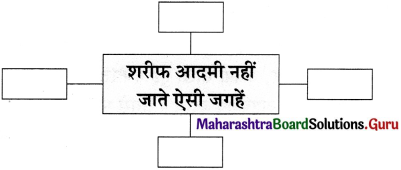
उत्तरः
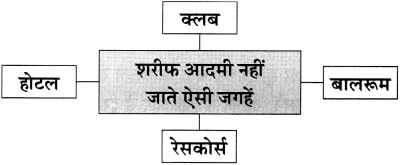
प्रश्न 12.
(i) कारण लिखिए
(1) प्राणनाथ को नौकर बदतमीज लगा।
(2) प्राणनाथ ने मित्र की पत्नी को सलाह दी कि उसके पति को मजबूत नकेल की जरूरत है।
उत्तरः
(1) क्योंकि प्राणनाथ लंबी दूरी पैदल चलकर अपने मित्र को देखने आए थे और नौकर ने दरवाजे पर उनसे पूछा था फर्माइए।
(2) क्योंकि उनका मित्र पिकनिक में नहीं आया था और न आने का उचित कारण भी नहीं बता सका।
(ii) परिच्छेद के आधार पर दो ऐसे प्रश्न बनाइए जिनके उत्तर निम्न शब्द हो –
(1) दर्शन
(2) मजाक
उत्तरः
(1) दर्शन – प्राणनाथ पैदल चलकर क्यों आए थे?
(2) मजाक – प्राणनाथ को क्या छोड़ने को कहा?
प्रश्न 13.
(i) परिच्छेद से उपसर्गयुक्त शब्द ढूँढकर लिखिए :
(1) …………………………………..
(2) …………………………………..
उत्तरः
(1) बदतमीजी
(2) सौभाग्य
(ii) अनेक शब्दों के लिए एक शब्द लिखिए
(1) ऊँट, बैल आदि की नाक में बँधी हुई रस्सी –
(2) कोई बड़ा आदरणीय व्यक्ति –
उत्तरः
(1) ऊँट, बैल आदि की नाक में बँधी हुई रस्सी – नकेल
(2) कोई बड़ा आदरणीय व्यक्ति – महानुभाव

प्रश्न 14.
‘अतिथि देवो भव’ भारतीय संस्कृति है, इसे १० – १२ पंक्तियों में स्पष्ट कीजिए :
उत्तरः
भारतीय संस्कृति की कई विशेषताएँ हैं। “अतिथि देवो भव'” भारतीय संस्कृति की एक विशेषता है। जब अतिथि को देवता ही मान लिया तो उसके लिए बड़े से बड़ी कुर्बानी भी देने को तैयार हो जाते हैं हम। पुराणों में इसके कई उदाहरण मिलते हैं।
राजा मयुरध्वज अतिथि के स्वागत के लिए खुद को आरे से चिरवाने को भी तैयार हो गए थे। यही परंपरा हम आज भी निभाते हैं। अनेक कठिनाइयों का सामना करते हए भी हम अतिथि का स्वागत करते हैं।
अतिथि सत्कार के संस्कार हम भूल नहीं सकते। अपनी इच्छाओं का समर्पण करने के लिए हम सदैव तैयार रहते हैं। यह हमारा अतिथि प्रेम ही हैं।
आज इस परंपरा में कमी जरूर आई हैं। क्योंकि पहले अतिथि छठे -छमासे आते थे। समय,धन और जगह की कमी नहीं थी और मनोरंजन के साधन भी सुलभ नहीं थे। उस समय अतिथि के पधारने पर मन आनंदित हो उठता था। आज की महानगरीय सभ्यता में समय, स्थान और धन का अभाव है।
ऐसे में अतिथि पधारने पर कई कठिनाइयों का सामना करना पड़ता हैं। फिर भी हम अतिथि का सत्कार करते ही हैं। अपनी संस्कृति को भूल नहीं सकते। और हमें भी तो कभी किसी का अतिथि बनना पड़ता हैं।
प्रश्न 15.
गद्यांश पढ़कर दी गई सूचनाओं के अनुसार कृतियाँ कीजिए:
उत्तरः
छोटे गोल मुख की तुलना में कुछ अधिक चौड़ा लगनेवाला, पर दो काली रूखी लटों से सीमित ललाट, बचपन और प्रौढ़ता को एक साथ अपने भीतर बंद कर लेने का प्रयास-सा करती हुई, लंबी बरौनियोंवाली भारी पलकें और उनकी छाया में डबडबाती हुई-सी आँखें, उस छोटे मुख के लिए भी कुछ छोटी सीधी-सी नाक और मानो अपने ऊपर छुपी हुई हँसी से विस्मित होकर कुछ खुले रहनेवाले होंठ समय के प्रवाह से फीके भर हो सके हैं, धुल नहीं सके।
घर के सब उजले-मैले, सहज-कठिन कामों के कारण, मलिन रेखाजाल से गुंथी और अपनी शेष लाली को कहीं छिपा रखने का प्रयत्न-सा करती हुई कहीं कोमल, कहीं कठोर हथेलियाँ, काली रेखाओं में जड़े कांतिहीन नखों से कुछ भारी जान पड़ने वाली पतली ऊंगलियाँ, हाथों का बोझ सँभालने में भी असमर्थ-सी दुर्बल, रूखी पर गौर बाँहें और मारवाड़ी लहँगे के भारी घेर से थकित-से, एक सहज-सुकुमारता का आभास देते हुए, कुछ लंबी उँगलियों वाले दो छोटे-छोटे पैर, जिनकी एड़ियों में आँगन की मिट्टी की रेखा मटमैले महावर-सी लगती थी, भुलाए भी कैसे जा सकते हैं!
उन हाथों ने बचपन में न जाने कितनी बार मेरे उलझे बाल सुलझाकर बड़ी कोमलता से बाँध दिए थे। वे पैर न जाने कितनी बार, अपनी सीखी हुई गंभीरता भूलकर मेरे लिए द्वार खोलने, आँगन में एक ओर से दूसरी ओर दौड़े थे। किस तरह मेरी अबोध अष्टवर्षीय बुद्धि ने उससे भाभी का संबंध जोड़ लिया था, यह अब बताना कठिन है।
मेरी अनेक सहपाठिनियों के बहुत अच्छी भाभियाँ थीं; कदाचित् उन्हीं की चर्चा सुन-सुनकर मेरे मन ने, जिसने अपनी तो क्या दूर के संबंध की भी कोई भाभी न देखी थी, एक ऐसे अभाव की सृष्टि कर ली, जिसको वह मारवाड़ी विधवा वधू दूर कर सकी।
बचपन का वह मिशन स्कूल मुझे अब तब स्मरण है, जहाँ प्रार्थना और पाठ्यक्रम की एकरसता से मैं इतनी रुआँसी हो जाती थी कि प्रतिदिन घर लौटकर नींद से बेसुध होने तक सबेरे स्कूल न जाने का बहाना सोचने से ही अवकाश न मिलता था।

प्रश्न 16.
चौखट पूर्ण कीजिए :
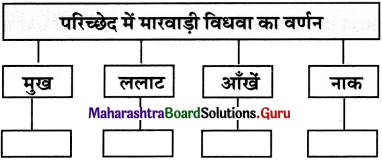
उत्तरः
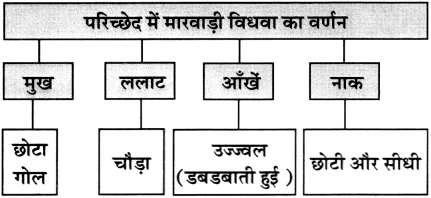
प्रश्न 17.
(i) कारण लिखिए –
(1) भाभी की हथेलियाँ मलिन रेखाओं से गुंथी कठोर हो गई थी।
(2) लेखिका स्कूल न जाने का बहाना सोचती रहती थी।
उत्तरः
(1) क्योंकि घर के सब उजले – मैले, सहज – कठिन काम भाभी को ही करने पड़ते थे।
(2) क्योंकि मिशन स्कूल में प्रार्थना और पाठ्यक्रम की एकरसता उन्हें अच्छी नहीं लगती थी।
(ii) निम्नलिखित विधान सही है या गलत लिखिए –
(1) भाभी ने लेखिका के उलझे बाल सुलझाकर कसकर बाँध दिए थे।
(2) लेखिका की अनेक सहपाठिनियों के बहुत अच्छी भाभियाँ थीं।
उत्तरः
(1) भाभी ने लेखिका के उलझे बाल सुलझाकर कसकर बाँध दिए थे। – गलत
(2) लेखिका की अनेक सहपाठिनियों के बहुत अच्छी भाभियाँ थीं। – सही
प्रश्न 18.
(i) परिच्छेद से विलोम शब्द की जोड़ियाँ ढूँढ़कर लिखिए –
जैसे – कोमल x कठोर
वैसे – (1) ………………………………….
(2) ………………………………….
(3) ………………………………….
(4) ………………………………….
उत्तरः
(1) बचपन x प्रौढ़ता
(2) उजले x मैले
(3) सहज x कठिन
(4) उलझे x सुलझे

(ii) ‘आभास’ शब्द से नए अर्थपूर्ण शब्द बनाइए।
(1) ………………………………….
(2) ………………………………….
(3) ………………………………….
(4) ………………………………….
उत्तरः
(1) आस
(2) भास
(3) आभा
(4) सभा
प्रश्न 19.
‘विधवा समाज और परिवार से प्रताड़ित जीवन जीने पर मजबूर होती है इस तथ्य पर अपने विचार लिखिए।
उत्तरः
हमारे समाज में सामाजिक रूढियों एवं परंपराओं की बेड़ियों में जकड़ी विधवाओं की स्थिति बड़ी दयनीय है। विधवा होते ही उन पर तमाम बंदिशे लग जाती हैं। न तो वह कहीं आ जा सकती हैं न मन माफिक खा और पहन सकती है। परिवार और समाज से प्रताड़ित विधवा का जीवन घोर निराशता से भर जाता है। रंगीन वस्त्र पहनना वर्जित हो जाता है और सफेद लिबास में लिपटी रहना उसकी नियती।
दूसरा विवाह कर सुनहरे भविष्य की आशा से भी उसे वंचित कर दिया जाता है। बिना रोशनदान, बिना झरोखा, बिना नौकर चाकर और बिना पशु पक्षियों वाले अँधेरे घर में घुट – घुटकर जीने को उसे विवश किया जाता है। समाज विधवा पर संयम और अनुशासन से रहने की बंदिशें तो लगाता है पर उसके आहार – विहार, मनोरंजन एवं स्वास्थ के प्रति कठोर और उदासीन रहता है।
पति के जीवित रहते जो घर की स्वामिनी थी ,मृत्यु के बाद उसे दासी समझा जाने लगता है। बाल विधवा के साथ तो समाज और क्रूरता का व्यवहार करता है। छोटी छोटी भूलों पर उसे मारा-पिटा और दागा जाता है । उसे पशु से भी बदतर जीवन जीने को विवश किया जाता है।
समाज की घिनौनी पाशविक प्रवृत्ति के चलते बाल-विधवा को छोटी उम्र में ही प्रौढ़ और वृद्ध बनने पर मजबूर कर दिया जाता है। इस तरह विधवाओं को समाज की संकीर्ण और विकृत मानसिकता का शिकार होना पडता है।
प्रश्न 20.
परिच्छेद पढ़कर दी गई सूचनाओं के अनुसार कृतियाँ कीजिए:
उत्तरः
सन 1947 में भारत आजाद हुआ। वास्तव में व्यापार और उद्योग देश की रीढ़ की हड्डी के समान होते हैं, परंतु … समाजवादी समाज रचना का लक्ष्य होने से सरकार ने इनके विकास की ओर ध्यान नहीं दिया। मुक्त और उदार अर्थव्यवस्था से … ही आर्थिक और औद्योगिक विकास संभव है- इस बात को समझने में हमारे नेताओं को चौंतीस वर्ष लगे।
शंतनुराव जी आरंभ से ही इस नीति के समर्थक थे। उनके विचारों के अनुसार ‘सादा रहन-सहन’ ही बेरोजगारी की जड़ है। रोजगारी से निर्माण हुई वस्तुओं का प्रयोग किए बिना रोजगारी कैसे चलेगी? यदि कोई शानदार बंगला, श्रेष्ठ संगीत, बढ़िया कपड़ा या साड़ी इस्तेमाल ही न करे, तो देश में गरीबी और बेरोजगारी बढ़ती ही जाएगी। इनको रोकने के लिए हर एक को अपनी जरूरतें बढ़ानी होंगी।
उद्यमकर्ता कामगारों का शोषण नहीं करता, उल्टे-उन्हें काम देकर गरीबी की खाई से बाहर निकालता है।
आधुनिक जेटयुग के इस महापुरुष ने किर्लोस्कर ब्रदर्स कंपनी के अंतर्गत विभिन्न उत्पादन, व्यवसाय करने वाली लगभग चालीस कंपनियाँ खोलकर उसे किर्लोस्कर उद्योग समूह में परिवर्तित किया। वे कहा करते, “जो भी काम करो, बढ़िया ढंग से करो और उसमें सफलता पाने के लिए मुसीबतों की परवाह न करते हुए, अंत तक मन को थकने न दो।”
आपने इंजीनियरी क्षेत्र के अलावा होटल, परामर्शसेवा (कन्सलटन्सी), संगणक, लीजिंग तथा फाइनान्स आदि क्षेत्रो में भी भरसक योगदान दिया।
आपको 1965 में पद्मश्री, सन 1984 में ‘मराठा चेंबर ऑफ कॉमर्स’ की मानद सदस्यता और सन 1988 में पुणे विश्वविद्यालय की डी. लिट. उपाधि से सम्मानित किया गया। इनके अलावा इंजीनियरी क्षेत्र में उल्लेखनीय कार्य करने के उपलक्ष्य में उन्हें विभिन्न पुरस्कार मिले। औद्योगिक क्षेत्र में उनका जो महत्त्वपूर्ण अंशदान रहा, उसी के कारण आपको औद्योगिक क्षेत्र के भीष्माचार्य’ कहा जाता है।

प्रश्न 21.
संजाल पूर्ण कीजिए।
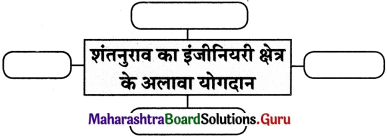
उत्तरः
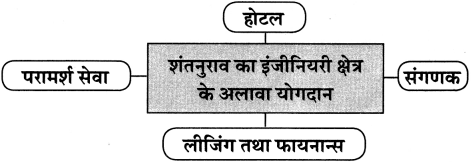
प्रश्न 2.
(i) कारण लिखिए –
(1) सादा रहन-सहन ही बेरोजगारी की जड़ है।
(2) शंतनुराव को औद्योगिक क्षेत्र के भीष्माचार्य कहा जाता है।
उत्तरः
(1) क्योंकि शानदार बंगला, श्रेष्ठ संगीत, बढ़िया कपडे इस्तेमाल ही न करेंगे तो देश में गरीबी और बेरोजगारी बढ़ती ही जाएगी।
(2) क्योंकि उनका औद्योगिक क्षेत्र में बहुत बड़ा योगदान रहा है।
(ii) सही विकल्प चुनकर लिखिए –
(1) व्यापार और उद्योग …………………………… की रीढ़ की हड्डी के समान होते हैं। (व्यक्ति / देश / समाज)
(2) मुक्त और उदार …………………………… से ही आर्थिक और औद्योगिक विकास संभव है। (अर्थव्यवस्था / नीति संस्कार)
उत्तरः
(1) व्यापार और उद्योग देश की रीढ़ की हड्डी के समान होते है।
(2) मुक्त और उदार अर्थव्यवस्था से ही आर्थिक और औद्योगिक विकास संभव है।
प्रश्न 3.
(i) अंग्रेजी शब्दों के हिंदी अर्थ लिखिए :
(1) फाइनान्स – ……………………………
(2) कॉमर्स – ……………………………
(3) इंजीनियरी – ……………………………
(4) चेंबर – ……………………………
उत्तरः
(1) फायनान्स – वित्त
(2) कॉमर्स – वाणिज्य
(3) इंजीनियरी – तकनिकी
(4) चेंबर- कक्ष
(ii) निम्नलिखित शब्दों के विलोम लिखिए :
(1) आजाद x ……………………………
(2) समर्थक x ……………………………
(3) पुरस्कार x ……………………………
(4) सम्मानित x ……………………………
उत्तरः
(1) आजाद x गुलाम
(2) समर्थक x विरोधक
(3) पुरस्कार x दंड
(4) सम्मानित x अपमानित

प्रश्न 4.
सफल उद्योजक के गुण 10-12 वाक्यों में लिखिए।
उत्तरः
सफल उद्योजक बनने के लिए चुनौतियों से भरी राह पर निरंतर गतिशील रहते हुए आगे बढना होगा। उत्पादन के लिए महत्त्वपूर्ण है कच्चा माल, मशीनें और कर्मचारी जो प्रशिक्षित हो। इन तीनों के अभाव में उत्पादन संभव नहीं। ये तीनों हैं और उत्पादन भी अच्छी तरह से हो गया तो उत्पादन को बेचने के लिए बाजार भी चाहिए। उद्योजक को चाहिए कि वह अपने उत्पादन का स्तर हर हाल में उच्च कोटी का रखे, जो भी उत्पादन हो वह बढ़िया से बढ़िया हो।
हर समस्या को बारिकी से जानने समझने की जिज्ञासा उसमें हो, कठिनाइयों से जूझने की दृढ़ता उसमें हो। जोखिम स्वीकारने के लिए वह सदैव तत्पर रहे। वह दूरदर्शी होना चाहिए, अगले 50-100 वर्षों का अनुमान लगाने की क्षमता उसमें हो। उसका दृष्टिकोण व्यावहारिक हो।
अपने कर्मचारियों के प्रति विश्वास और स्वयं पर भरोसा होना चाहिए। बाजार की प्रतिस्पर्धा में टिकने के लिए अनगिनत कष्ट उठाने की उसकी तैयारी होनी चाहिए। वह पहले दर्जे का संयोजक एवं प्रबंधक होना चाहिए और सबसे महत्त्वपूर्ण बात वह महत्त्वाकांक्षी होना चाहिए। इतने सारे गुण जिस उद्योजक के पास है वह नाम और शोहरत कमाएगा और सफलता की चोटी पर पहुँचेगा।
![]()

![]()
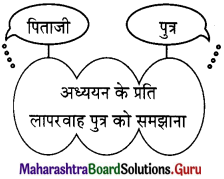
![]()

![]()

![]()




